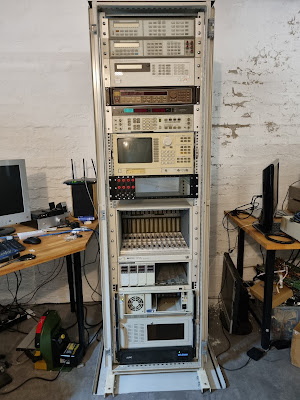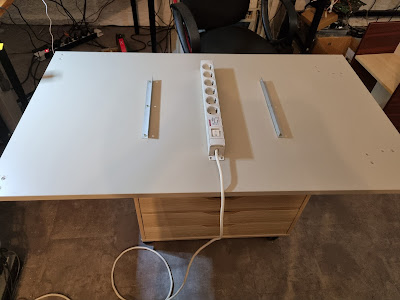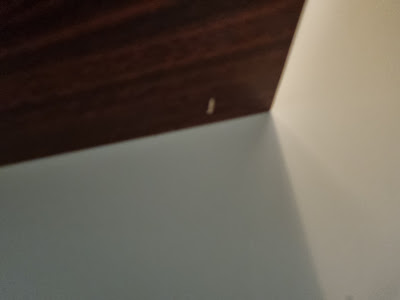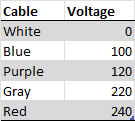I was thinking about some Panduit modular patch panels, but never bought it. So just left it.
2023. szeptember 16., szombat
Building my rack(s)
I was thinking about some Panduit modular patch panels, but never bought it. So just left it.
2023. szeptember 5., kedd
Fluke 787 "Repair"
"i purchased this at an estate sale. i don't know if it works or how to turn it on. but as it is right now i have pushed every button and nothing comes on the screen. so because of that i am selling it for parts or repair."
2023. augusztus 27., vasárnap
Dumpster Dive - "woodwork"
2023. augusztus 22., kedd
Photography
There is some (re)addition to my hobbies.
A few years ago (mainly at the film based era), I was seriously involved in the amateur photography. Went nowhere without an SLR camera. A few years ago, this swept away a bit. There are many reason behind it. I guess the main reason was the better and better cameras in the smart phones.
Anyway, I was never completely satisfied with the performance of it. It was good for documenting my electronics projects but... It was good for my daily needs but...
Then the COVID came. It bring with it a closing down the things. Working in IT with cloud technologies bring almost zero need to go to into an office. My main hobby (still will be) electronics is connected to my lab, what is a closed space. Actually days passed by without going out to the street.
It looks like two and a half year was the limit to me to be able to tolerate this kind of lifestyle. Enough.
So a few weeks ago, I took out my photo equipment from the locker and started to use it. With it, go out to the city, to countryside, just for taking pictures. I love this feeling.
I also plan to move from phone to this equipment also for other photo/video related activities. For this plan, I started to upgrade my set a bit. It doesn't mean buying new equipment. Much more started to collect 2nd hand tools. Added an FX camera (Nikon D610) to be able to utilize the lenses from my film era. Added macro lenses for my object photography goals.
The current set:
My new photography journey starts here.
2023. június 28., szerda
Keithley 2700 - Repair 2.
2023. június 13., kedd
2023. június 12., hétfő
Reference Resistors
A friend of mine asked me for a quick project (finally it become not so quick, but just because the time it required the parts to arrive).
He is installing pool and other water handling related systems. One of the pool measure system has PT100 temperature sensor input what need calibration. The proper calibration equipment cost a fortune. Actually he only need two reference point. For this he asked me to make some reference resistors in a box what is precise enough and has low tempco.
The values are 100 ohms and 119.4 ohms what is weird a bit. Looked around and find the required resistors in 0603 and 0805 size (100 and 120 ohms 0.01% 2ppm) around $10 each. For the 119.4 ohms I planned 24k in parallel with the 120 ohms (bit less precision as there is not needed better).
I bought some tiny aluminum boxes from the AliExpress. The idea to change the front plate of the boxes to a PCB add the screw-in banana sockets and put the resistors to the back of the boards.
It looks like this:
It was manufactured by PCBWay in the usual excellent quality - Thank you!
I was a bit afraid, if they can follow my request and put the order number to the already crowded component side, but it was managed without problem. It arrived together with my VFD project board, what I'll write about later.
The board soldered (Yes, it is a joke. Only one single resistor in this case)
Some measurements
If I count the cable and the plugs contact resistance is the result get even better. I'm satisfied with the result.
And the final boxes (the request was about two units.
I put two resistance values into a single box. The only thing left is to print some labels on it with the values.
Spectrum Analyzer
- Audio measurements. I need to cover let say from 10Hz to 100kHz. Yes, this is wider than the audio range, but it is good to know, what the electronics do outside it.
- SMPS measurements. I'd like to characterize the noise of the things I buy or build, get EMI probes, etc. No, I don't need it for FCC or similar acceptance, just to know, what I bought it a quality unit, or a heap of crap. I guess the frequency range is from 20kHz to a few MHz. Also I intend to find out, the ideal frequency of unknown SMPS transformers. I guess later also need a tracking generator.
- Characterize frequency references. Lately I was playing with rubidium standard, I have also a few OCXOs in my parts box, for later use. Intend to build a GPSDO or similar unit. Those things are running around 10MHz
- Repair characterize maybe calibrate AM/FM generators. It happened to fall four Panasonic/Levar VP-8193A/D onto my bench. All of them has issues in the RF section (looks like the control part works perfectly, the LF part I didn't check yet). For repairing, later calibrating it. For those I need a frequency range from around 100kHz to around 200MHz. It also need analog modulation analysis for AM and FM.
- Sub GHz and GHz digital communication. It is in my mind to play with 433kHz, 868kHz, ZigBee, Z-Wave, LoRa, Bluetooth and WI-Fi. The sub GHz can be handled by most of the analyzers but the 2.4GHz is a different story. Also those things are requiring some kind of Digital Modulation Analysis, what not all of the SA has.
- Hack-RF SDR https://greatscottgadgets.com/hackrf/one/. It is by design is not a test equipment. I need to figure out, get some advise, if I can use it for any of the functions above. It maybe good as SA, AMA, DMA for the RF range, but has no idea what can be achieved with it or even good enough for measurements. Didn't use it up to know just have it in the drawer for a while.
- Boonton 8201 Modulation Analyzer. Probably good for the AMA function (if it works, not yet tested)
- Rigol MSO-5074 (with all of the options added, so it is a highly capable 4 Ch, 350MHz, 8Gsps oscilloscope). I think the FFT function can be good for some of the low frequency measurements, but I'm afraid of the ADCs 8bit resolution for this kind of sensitivity required work.
- HP 35665A Dynamic Signal Analyzer. Probably good for most of the audio related work together with the other audio equipment I have
- Steinberg UR22 mkII external sound card. Plan to use for audio. There are quite capable software available for free online, I also have a measurement microphone, power amplifier, Dayton DATS v2 to extend the capabilities of the computer based measurements.
- HP 8903B Audio Analyzer. This is a highly capable unit, but unfortunately I can't count on it currently as it need repairs/calibration. The linearity in the frequency range is a way off even just connected its generator output, to its input
- Keithley 2015 THD multimeter. It is able to commence some of the functions of the 8903B.
- Doesn't buy anything just try to utilize my current equipment for the purpose above. It may work, but deffinetely need some advise, starting points for information.
- TinySA Ultra. It is probably able to fulfill most of my RF needs. I just not yet know if it has drawbacks other than the small display. Some more research will be needed.
https://eleshop.eu/tinysa-ultra-spectrum-analyser.html - Owon XSA-1015P-TG. It seams to be a great unit. I checked this video:
It looks like, on most of the parameters it is better than the Rigol (I was considering previously, but based on my research I dropped it already). For €975 it is a great deal https://eleshop.eu/owon-xsa1015-tg.html. - Siglent SSA3021X-Plus. This is a similar unit as the previous Owon, but it cost a bit more €1469 https://eleshop.eu/siglent-ssa3021x-plus-spectrum-analyzer.html.It has upgradability to 3.2GHz (covering the Wi-Fi and Bluetooth band), has AMA and DMA option. I didn't see any of those in the Owon specification.
But still, there are some things I miss in both of the units: - Not covering the audio band
- The TG minimum frequency on both units starts at 100kHz, what is too high for testing SMPS parts.
- Signal Hound SA44B Spectrum Analyzer + TG44A Tracking Generator. Those units together are bit above the budget what I willing to spend ($1930 together) https://signalhound.com/products/4-4-ghz-scalar-network-analyzer/
It looks like resolve my low frequency questions as it start at 10Hz (both the SA and TG).
I'm a bit afraid being solely PC based USB device, and not yet sure if all of the functions are available I'd like to have. Actually I found a review video on it.I not yet watched it as it is two hours long. I should find the time before I decide.
2023. május 29., hétfő
Keithley 2700 - Repair
I couldn't resist. Found this puppy faulty on the eBay.
It doesn't turn on. Even consume zero current from the mains.
For a quick look: the fuse is intact. Tested the AC connections from the mains transformer. Nothing come out. Ok, so either the mains transformer or the mains connector module (connector, voltage selector, mains switch) faulty.
Checked the Mains connector module. Unfortunately the available service manual is useless. So with the mains module, done some reverse engineering.
Here is the transformer's connection:
Measuring the transformer I found out, that the 100V winding is demaged.
So, I connected the 100V - 220V cables (blue and gray) to my variac, and set the voltage to 120V.
Here are the results:
For the first sight, it looks like, it has no other issue than the faulty mains transformer. Now I need to find a replacement unit, or somebody, who is able to wind a new one for me.
2023. május 22., hétfő
Analog Multimeter 3. - PCBWay Review
My boards arrived Yesterday from PCBWay.
As this is the first time I use them as board house I'd like to write a small review here.
I'm ordering PCBs from various manufacturers in the last 14 years. I started with some local manufactures. Those guys had horrible prices and not so good quality (anything above the single side board had additional cost, etc.)
10 years ago I changed to the board houses located in China. As my projects mostly has no time constraints, the long delivery time hadn't be an issue to me.
There were a certain PCB size what manufactured on the low cost ($5 + shipping). This started with 50x50mm, then become 70x70 and lately 100x100. Almost all of the manufacturers today provide 10pcs 100x100mm two sided, masked, silkscreen printed boards for 5$ + shipping.
This is where we stand today.
Lets check the order process of PCBWay. I had a simple 100x50mm board, for prototyping my SuperTracking regulator (based on Walt Jung/Jan Didden design).
It is a great thing to have a gerber viewer and automatic size calculator in your order process. Here the PCBWay site tricked me a bit. I didn't find this feature on the first sight. It is not reside on the main ordering page you see at first. You need to switch to the "Quick-order PCB" page to get this.
I absolutely love this feature:
It means you order your PCB with HASL (tinned) finish and if you are lucky you get ENIG (gold plated) finish. To understand, the manufacturers put your hobby projects into the big orders process. If you tick this checkbox, you may get a gold finish. The manufacturer on the other side has greater flexibility where they put your order. This is an absolutely win-win situation.We care about the environment. The EU doesn't allow lead based solders for a while in the consumer electronics devices. At the board houses, you can select between the leaded and the lead free finish. The manufacturers I seen previously charge extra for the lead free finish. This come from PCBWay with no additional cost.
If you ordered already PCBs, you always find a tiny order number on your board somewhere. In most of the cases this doesn't cause any problems. You have the paying option to remove this number. This is not always necessary. Check my previous design, what is the scale of the meter under design. There could be a problem to see this number on the visible area of the board. Here you can add special request written where you want to place this number. At other sites I seen a method, you can add a specially formatted text to your silkscreen where the manufacturer can put this number. I feel this point as room for improvement.
At PCBWay you pay your order after the review (in few hours - it took me a day, probably because I ordered my board during the weekend). Other manufacturers require the payment upfront. I think it is matter of taste. I prefer this method. It give me some time to review myself if everything is ok, I didn't make a mistake at the order (unfortunately paying upfront caused me trouble in the past).
One additional thing about the order process. Providing and stating to provide IOSS (Import One-Stop Shop) is a help for the EU customers from two point: the order arrive faster and you don't need to do the paperwork at the local customs or tax authorities.
The order of mine arrived on Monday.
The quality of the boards are excellent. Didn't find any issue with it. This is the quality I expect from the boards I want to use.
I was eager to populate it as soon it arrived. I was sure that all of the required components arrived. Jumped into the build. Immediately realized that three parts are missing.
One is the voltage reference I intend to use. It is my fault, forget to order it.
The other two is the dual OpAmp and the small NPN transistor. I got a message from Mouser: "Shipments of this product must be direct to an END CUSTOMER from an AUTHORIZED DISTRIBUTOR only. Your customer must order this product directly from Mouser or another authorized distributor."
Come on! I never sold components as a reseller. I'm just an engineer who time-to-time fix things, design equipment.
Contacted Mouser, It took around three days to settle this.
So yesterday finally ordered the remaining components. Waiting for the arrival.

















































